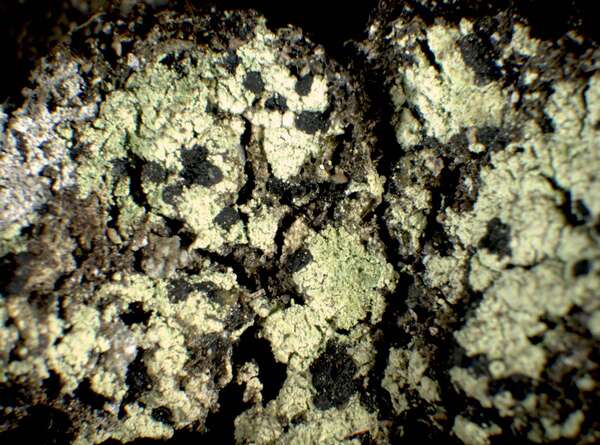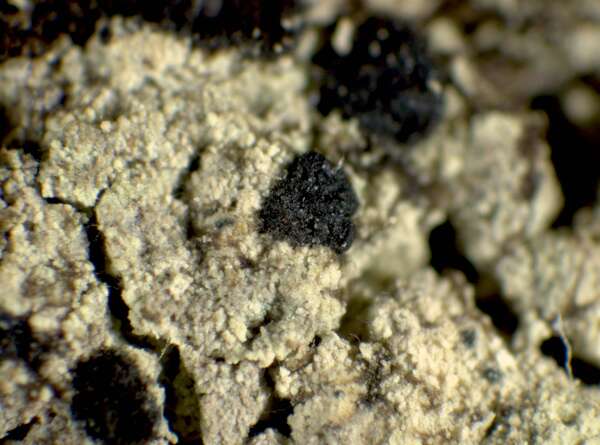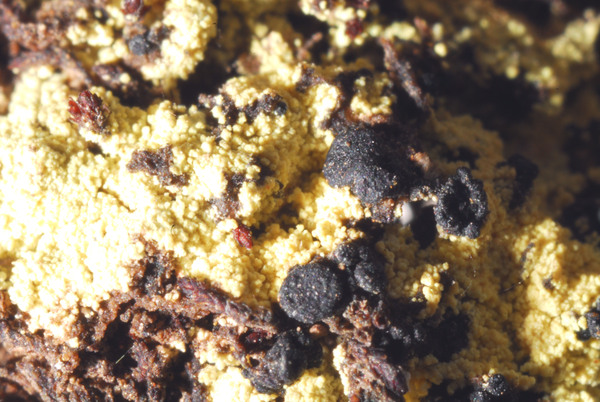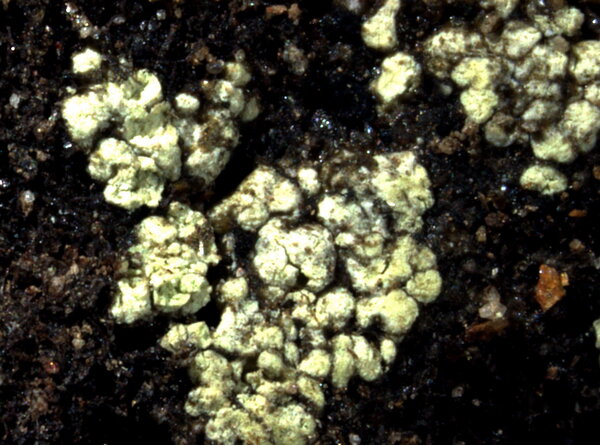Arthrorhaphis vulgaris (Schaer.) Frisch, Y.Ohmura, Holien & Bendiksby
Taxon 2022: 21, 2022. Basionym: Lecidea flavovirescens var. vulgaris Schaer. - Lich. Helv. Spic.: 162, 1833
Synonyms: Arthrorhaphis citrinella auct. non (Ach.) Poelt; Bacidia flavovirescens var. detrita Vain.
Distribution: N - Frl (Obermayer 1994, Tretiach & Hafellner 2000), Ven (Obermayer 1994), TAA (Obermayer 1994, Bilovitz & al. 2014, Nascimbene & al. 2022), Lomb, Piem (Isocrono & al. 2004, Isocrono & Piervittori 2008), VA (Piervittori & al. 2001). C - Abr (Di Nuzzo & al. 2021, Gheza & al. 2021), S - Cal (Puntillo 1996), Si (Obermayer 1994).
Description: Thallus crustose, areolate, forming small irregular colonies on acidic soils, terricolous bryophytes or plant remains, or starting the life-cycle on species of Baeomyces, up to 6 cm across, the areoles greenish yellow, matt to slightly shiny, discrete to mostly confluent, irregularly rounded to elliptical-lobate, moderately convex to bullate, 0.2-1.7 mm across, smooth to verrucose, the surface entire to cracked or disintegrating into fine to coarsely granular soredia measuring 0.03-0.15 mm. Medulla up to 0.5 mm thick, yellow, often absent, without Ca-oxalate crystals. Apothecia lecideine, black, usually separate from the lichenized thallus, 0.3-1.5 mm across, single or in groups of 2-15, adnate to shortly and broadly stipitate, matt, with a flat to convex, more or less coarsely rugose disc, the margin initially thick and protruding, later level with disc. Proper exciple 40-80 μm wide, dark brownish olive-green, darker towards the outer edge; epithecium brownish olive-green, 12-25 μm high, N+ green; hymenium colourless to pale olive-green, densely inspersed with oil droplets, 80-130 μm high; paraphyses sparingly branched and anastomosing, 1-1.5 μm thick; hypothecium brownish olive-green, 40–75 μm high. Asci 8-spored, bitunicate, clavate, I-, scarcely thickened at apex, with a small ocular chamber, 80-115 x 10-12 μm. Ascospores (5-)7-11(-16)-septate, hyaline, acicular. parallel in the asci, (34-)51-72(-89) x (2-)2.2-3.2(-3.5) μm. Photobiont chlorococcoid. Spot tests: thallus K-, C-, KC-, P-, UV+ orange. Chemistry: rhizocarpic acid (major), epanorin (minor).
Note: the revision by Frisch & al. (2022) showed that A. citrinella s.lat. can be subdivided into several species. A. citrinella s.str., characterized by a thallus entirely consisting of small loose to compact aggregations of granular soredia, growing on saxicolous bryophytes, while common in Northern Europe, appears to be much rarer in the Alps than the recently-described A. vulgaris. The latter has a thallus of discrete to confluent areoles, growing on soil, terricolous bryophytes and plant remains, or parasitic on Baeomyces. In the TSB herbarium there is no sample from the Italian Alps corresponding to A. citrinella s.str., so I have provisionally attributed all of its records to A. vulgaris.
Growth form: Crustose
Substrata: soil, terricolous mosses, and plant debris
Photobiont: green algae other than Trentepohlia
Reproductive strategy: mainly asexual, by soredia, or soredia-like structures (e.g. blastidia)
paras Baeomyces spp.
Commonnes-rarity: (info)
Alpine belt: rather common
Subalpine belt: rather rare
Oromediterranean belt: rare
Montane belt: extremely rare
Submediterranean belt: absent
Padanian area: absent
Humid submediterranean belt: absent
Humid mediterranean belt: absent
Dry mediterranean belt: absent

Predictive model
Herbarium samples


P.L. Nimis; Owner: Department of Life Sciences, University of Trieste
Herbarium: TSB (24570)
2001/12/13


P.L. Nimis; Owner: Department of Life Sciences, University of Trieste
Herbarium: TSB (24570)
2001/12/13
Growth form: Crustose
Substrata: soil, terricolous mosses, and plant debris
Photobiont: green algae other than Trentepohlia
Reproductive strategy: mainly asexual, by soredia, or soredia-like structures (e.g. blastidia)
paras Baeomyces spp.
Commonnes-rarity: (info)
Alpine belt: rather common
Subalpine belt: rather rare
Oromediterranean belt: rare
Montane belt: extremely rare
Submediterranean belt: absent
Padanian area: absent
Humid submediterranean belt: absent
Humid mediterranean belt: absent
Dry mediterranean belt: absent

Predictive model
| Herbarium samples |


P.L. Nimis; Owner: Department of Life Sciences, University of Trieste
Herbarium: TSB (24570)
2001/12/13


 DOLICHENS
DOLICHENS




